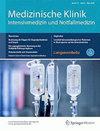[Hepatic encephalopathy].
引用次数: 1
Abstract
Hepatic encephalopathy (HE) may develop within the course of acute or chronic liver failure and is characterized by a complex of psychomotor symptoms. In addition, HE can be induced by portocaval shunting even in the absence of any apparent liver disease. HE is caused by substances, which are either reabsorbed from the gut or are a product of the body metabolism. Normally, these substances are effectively eliminated during their first passage through the liver. However, a decreasing number of functional hepatocytes or the presence of portocaval collaterals in liver disease may significantly impair hepatic detoxification. Ammonia seems to take a central position in the pathogenesis of HE, although the exact cerebral effects of this metabolite are still not known in detail. The actual pathogenetic hypotheses are subject of this review. Depending on the underlying liver disease, HE is divided into an acute and a chronic form. Chronic HE may be present as a persistent or an episodic form, the latter being usually induced by defined precipitating factors, such as diet failures, infection and gastrointestinal-bleeding. With regard to the psychomotor symptoms and the coma depth, the clinical picture is classified into five grades (West Haven criteria). Diagnosis is made by clinical examination of the mental status after relevant differential diagnoses have been excluded. The only causal therapeutic option in the presence of acute or chronic liver failure is liver transplantation. Therefore, the indication for transplantation has to be evaluated in all forms of HE. Symptomatic treatment has three principal aims: (1) stabilization of circulation, oxygen supply, blood sugar and nutrition; (2) identification of the precipitating factor and its removal; (3) reduction of ammonia and other potential toxins in the circulation. In the case of acute HE, these therapeutic aims are complemented by an effective prophylaxis or therapy of brain edema.(肝性脑病)。
肝性脑病(HE)可在急性或慢性肝功能衰竭的过程中发展,并以复杂的精神运动性症状为特征。此外,即使在没有任何明显肝脏疾病的情况下,门静脉分流也可以诱导HE。HE是由物质引起的,这些物质要么从肠道重新吸收,要么是身体代谢的产物。正常情况下,这些物质在第一次通过肝脏时就会被有效地清除。然而,肝脏疾病中功能性肝细胞数量的减少或门静脉侧络的存在可能会显著损害肝脏的解毒作用。氨似乎在HE的发病机制中占据中心位置,尽管这种代谢物对大脑的确切影响尚不清楚。实际的发病假设是本综述的主题。根据潜在的肝脏疾病,HE分为急性和慢性形式。慢性HE可表现为持续性或发作性,后者通常由明确的诱发因素引起,如饮食失败、感染和胃肠道出血。关于精神运动症状和昏迷深度,临床表现分为五个等级(West Haven标准)。排除相关的鉴别诊断后,通过对精神状态的临床检查进行诊断。急性或慢性肝功能衰竭的唯一因果治疗选择是肝移植。因此,移植的适应症必须在所有形式的HE中进行评估。对症治疗有三个主要目的:(1)稳定循环、供氧、血糖和营养;(二)沉淀因素的确定和排除;(3)减少循环中的氨和其他潜在毒素。在急性HE的情况下,这些治疗目的是补充有效的预防或治疗脑水肿。
本文章由计算机程序翻译,如有差异,请以英文原文为准。
求助全文
约1分钟内获得全文
求助全文

 求助内容:
求助内容: 应助结果提醒方式:
应助结果提醒方式:


